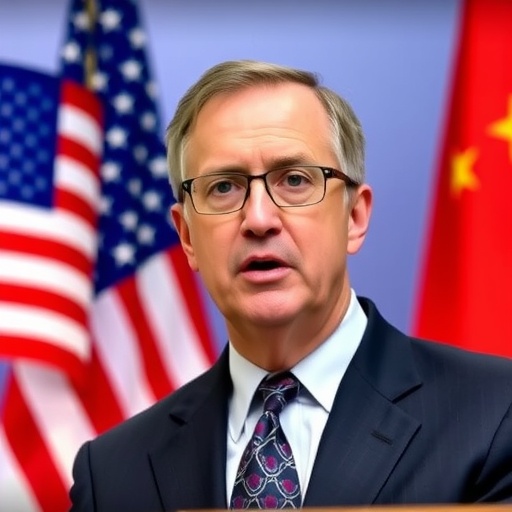Treasury Secretary Scott Bessent Announces U.S.-China Trade Framework to Avoid Tariffs Amid Government Shutdown Turmoil
In a pivotal moment for international relations, Treasury Secretary Scott Bessent revealed a groundbreaking framework agreement with China aimed at averting escalating tariffs and boosting U.S. agricultural exports, even as the U.S. government shutdown drags into its third week, threatening economic stability. Speaking from the White House briefing room on Thursday, Bessent described the deal as a “substantial step forward” that could inject billions into American farms while cooling trade tensions that have simmered for years.
- Bessent’s Beijing Breakthrough: Core Elements of the Trade Framework
- Agricultural Lifeline: China’s Pledge to Ramp Up U.S. Farm Buys
- Government Shutdown Strains: How Fiscal Gridlock Impacts Trade Talks
- Market Ripples and Expert Takes: Reactions to the Tariff Dodge
- Path Forward: Implications for U.S.-China Trade in Uncertain Times
The announcement comes at a critical juncture, with the government shutdown—now the longest in U.S. history—costing the economy an estimated $6 billion per week in lost productivity, according to the Congressional Budget Office. Bessent, a seasoned Wall Street veteran turned Treasury chief, emphasized that the trade progress offers a rare bright spot amid the domestic chaos, potentially stabilizing global markets rattled by uncertainty.
“This framework isn’t just about numbers on a page; it’s about securing jobs for American workers and farmers who have borne the brunt of trade uncertainties,” Bessent stated, his voice steady despite the backdrop of partisan gridlock in Congress. The deal, forged after months of secretive negotiations in Beijing and Washington, includes commitments from China to ramp up purchases of U.S. soybeans, corn, and pork—key agricultural staples hit hard by previous trade spats.
Details of the framework emerged as Bessent fielded questions on how the shutdown has hampered federal agencies involved in trade enforcement, including the U.S. Trade Representative’s office. With furloughed staff and delayed reports, the administration has leaned heavily on diplomatic channels to push forward, underscoring the urgency of de-escalating tariffs that could otherwise balloon to 25% on $300 billion in Chinese goods.
Bessent’s Beijing Breakthrough: Core Elements of the Trade Framework
Treasury Secretary Scott Bessent‘s trip to Beijing last month laid the groundwork for what he called a “pragmatic pathway” out of the trade impasse. In closed-door sessions with Chinese Vice Premier Liu He, Bessent hammered out a multi-phase agreement that prioritizes reciprocity in market access. At its heart, the framework pledges China to increase agricultural imports from the U.S. by at least $20 billion annually over the next three years, targeting products like soybeans, which saw exports plummet 75% during the height of the trade war in 2018.
“We’ve moved beyond rhetoric to real commitments,” Bessent explained during a press conference. The deal also includes provisions for intellectual property protections, a long-standing U.S. grievance, with China agreeing to faster enforcement against counterfeit goods and technology theft. In return, the U.S. has signaled a willingness to pause new tariffs, providing a 90-day window for implementation before any escalations.
Economists note that this framework builds on the Phase One trade deal signed in 2020 but goes further by addressing supply chain vulnerabilities exposed by the COVID-19 pandemic. For instance, the agreement facilitates joint investments in semiconductor production, aiming to reduce U.S. reliance on Chinese manufacturing. Data from the U.S. Department of Agriculture shows that such purchases could support over 100,000 jobs in rural America, from Iowa’s cornfields to Texas cattle ranches.
Yet, challenges remain. Critics argue the framework lacks enforceable mechanisms, pointing to China’s past shortfalls in meeting purchase quotas—only fulfilling about 60% of Phase One targets by 2022, per Peterson Institute for International Economics reports. Bessent countered this, assuring reporters that “monitoring will be robust, with quarterly reviews led by Treasury and USTR teams.”
Agricultural Lifeline: China’s Pledge to Ramp Up U.S. Farm Buys
For American farmers, the news couldn’t come soon enough. The U.S.-China trade framework spotlights agriculture as the immediate beneficiary, with China committing to procure an additional $12 billion in goods this fiscal year alone. Soybean farmers, who exported 36 million metric tons to China pre-trade war, have watched shipments dwindle amid retaliatory tariffs that once reached 25% on U.S. products.
“This is a game-changer for our heartland,” said Zippy Duvall, president of the American Farm Bureau Federation, in a statement praising Bessent’s efforts. Under the deal, China will prioritize U.S. pork amid its domestic swine fever recovery, potentially adding $5 billion to exports. Corn and wheat follow suit, with projections from USDA economists estimating a 15% uplift in farm incomes by 2025.
The economic ripple effects extend beyond the farm gate. Rural communities in the Midwest, already strained by low commodity prices and inflation, stand to gain from stabilized markets. A recent study by the Farm Journal Media Group highlights that trade disruptions have cost U.S. agriculture $27 billion since 2018, with tariffs acting as a double-edged sword—protecting some industries while punishing others.
Bessent detailed how the framework integrates with domestic relief efforts, noting that Treasury is allocating $2 billion from existing farm aid programs to bridge gaps during the government shutdown. “Farmers aren’t pawns in Washington politics; they’re the backbone of our economy,” he remarked, invoking images of empty silos and foreclosed lands to underscore the human stakes.
Environmental angles also weave into the narrative, as the deal encourages sustainable farming practices in exchange for premium pricing on U.S. exports. Chinese officials, facing their own food security pressures with a population of 1.4 billion, view this as a win-win, potentially easing domestic inflation rates hovering at 2.5%.
Government Shutdown Strains: How Fiscal Gridlock Impacts Trade Talks
The ongoing government shutdown, triggered by disputes over border security funding, has cast a long shadow over U.S.-China trade progress. With over 800,000 federal workers furloughed or working without pay, agencies like the Treasury Department and Commerce are operating at half-capacity, delaying tariff implementation and export verifications.
Treasury Secretary Scott Bessent addressed the strain head-on, revealing that shutdown-related delays have postponed key economic data releases, including trade balance reports critical for negotiations. The U.S. International Trade Commission, for example, has halted investigations into Chinese dumping practices, buying time for Beijing but frustrating U.S. manufacturers.
Economically, the shutdown’s toll is mounting. Moody’s Analytics projects a 0.3% GDP hit in the first quarter if it persists, with trade sectors particularly vulnerable. Imports from China have dipped 4% month-over-month, per Census Bureau figures, as businesses hesitate amid uncertainty. Bessent warned that prolonged inaction could erode the fragile trust built in recent talks, potentially reigniting tariff wars.
“The shutdown isn’t just closing parks; it’s closing doors on opportunity,” Bessent said, quoting a furloughed trade analyst who couldn’t attend a vital Geneva meeting. Bipartisan lawmakers, including Senate Finance Committee Chair Ron Wyden, have urged a resolution, arguing that domestic dysfunction weakens America’s hand against China.
Historical parallels abound: The 2018-2019 shutdown, lasting 35 days, saw a 10% drop in agricultural exports due to delayed inspections. This time, Bessent’s team has improvised with private-sector partnerships, enlisting firms like Cargill to handle some logistics. Still, the human cost—missed paychecks for 2 million contractors—fuels calls for compromise, with House Speaker Mike Johnson hinting at a vote next week.
Market Ripples and Expert Takes: Reactions to the Tariff Dodge
Wall Street reacted swiftly to Bessent’s announcement, with the Dow Jones Industrial Average climbing 1.2% in afternoon trading, buoyed by optimism over averted tariffs. Soybean futures on the Chicago Board of Trade surged 8%, reflecting investor bets on renewed Chinese demand. Broader indices, however, remain cautious, as the government shutdown injects volatility— the VIX fear index spiked to 22 amid shutdown fears.
Experts hailed the framework as a diplomatic coup. “Bessent has threaded the needle, balancing toughness with pragmatism,” opined Chad Bown, a senior fellow at the Peterson Institute. He noted that dodging 10-25% tariffs on electronics and machinery could save U.S. consumers $50 billion annually, per National Bureau of Economic Research estimates.
Critics, however, temper enthusiasm. Trade hawk Peter Navarro, former White House advisor, called it “a temporary truce, not a victory,” warning of China’s history of non-compliance. Labor unions like the AFL-CIO express concerns over job offshoring, demanding stronger labor standards in the deal.
Globally, the EU and Japan watch closely, with Brussels considering similar pacts to counter Chinese influence. A World Trade Organization spokesperson praised the de-escalation, stating it “eases pressure on multilateral systems strained by unilateral tariffs.”
In corporate boardrooms, companies like Boeing and Apple—hit hard by prior tariffs—breathe easier. Boeing, which lost $20 billion in orders during the trade war, anticipates a rebound in aviation exports. Tech giants, meanwhile, push for clarity on 5G restrictions embedded in the framework.
Path Forward: Implications for U.S.-China Trade in Uncertain Times
Looking ahead, the U.S.-China trade framework sets the stage for deeper engagement, but its success hinges on Congressional action to end the government shutdown. Bessent outlined next steps: a joint working group meeting in Shanghai next month to finalize agricultural protocols, followed by Treasury-led audits to ensure compliance.
If implemented, the deal could reshape global supply chains, fostering a “managed competition” model where rivals collaborate on issues like climate tech and rare earth minerals. Projections from the IMF suggest a 1.5% boost to U.S. GDP over five years, contingent on stable domestic politics.
Yet risks loom. Escalating tensions over Taiwan or human rights could derail progress, as could a prolonged shutdown eroding fiscal credibility. Bessent remains optimistic: “Trade isn’t zero-sum; it’s about building bridges that last.” As negotiators return to the table, the world watches whether this framework endures the storms of geopolitics and gridlock.
For American stakeholders, the message is clear: Relief is in sight, but vigilance is key. Farmers gear up for harvest season with renewed hope, while policymakers race against the clock to avert deeper economic scars.









